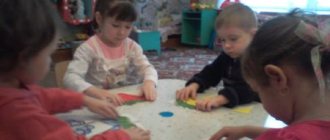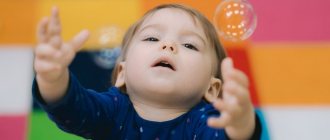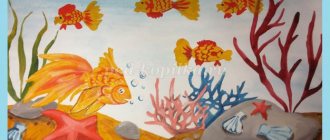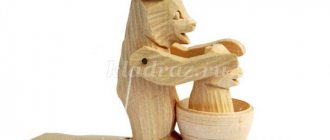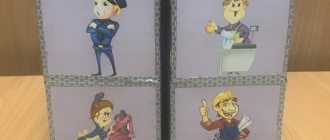Summary of OOD on sensory development in the middle group on the topic: “In search of Kolobok”
Municipal budgetary preschool educational institution
" CRR-kindergarten No. 15 " Forget-me-not "
Summary of OOD on sensory development in the middle group on the topic: "In search of Kolobok" Educator Tanashova A.M.
Target:
generalization and systematization of students’ knowledge about the sensory properties of objects.
Tasks:
1. Educational: Consolidate knowledge of primary colors (blue, green, red, yellow, geometric shapes (square, circle, oval, rectangle, sizes (long, short, high, low); Continue to learn how to assemble a complete image from parts.
2. Developmental: Develop coherent speech; Develop children's various senses - visual, tactile, auditory; Develop thinking abilities. Develop perception, attention, memory, imagination, fine motor skills.
3. Educational: Cultivate cognitive interest;
Develop the ability to listen to another person (peer, adult).
Cultivate a desire to help others who need our help.
Cultivate friendly attitudes towards each other during joint activities; Develop the ability to hear and perceive a task, and perform it independently.
Educational environment
:
- the nature of the interaction between subjects of activity: business communication in the position of teacher-group, child-educator (solving problems, completing tasks, exercises; cooperation in the position of child-child (helping each other).
- means of teaching and upbringing: educational (motivational) situation, means of stimulating cognitive activity, a map for finding Kolobok, toys - characters from the cartoon “Luntik and his friends”, recording of the characters’ voices, song-dance “Four Steps Forward”; paths - wide - narrow, long - short, mountains - high and low, stream; baskets - large, small; flower petals, cardboard suns (according to the number of children, yellow clothespins, large and small carrots, beans, peas, boxes (large, small, cut-out pictures, colored laces, picture pants with slits.
Leading area: cognitive development.
Integration of educational areas: “Cognition”, “Speech development”, “Physical development”, “Artistic and aesthetic development”.
Planned results: in the process of solving problem situations and entering play actions, children consolidate and systematize their acquired knowledge about sensory standards.
Previous work: watching the cartoon “Luntik and his friends”; didactic games for sensory development - to consolidate color, shape, size, to develop fine motor skills, etc.
Progress of activities:
1. Motivational and incentive stage:
Progress of the lesson:
Children, I’m glad to see you all, say hello to each other, hug your friends. Tell your little eyes: “Good morning, little eyes”!
Good morning, little eyes, are you awake? (Children stroke their eyelids).
Good morning, ears, are you awake? (Children stroke their ears).
Good morning cheeks, are you awake? (Children stroke their cheeks).
Good morning, hands, are you awake? (Children stroke their hands).
Good morning legs, are you awake? (Children stroke their legs).
Good morning, Sunshine! We woke up and smiled! (Stretch their hands up and smile broadly).
Children, look how many suns we have in our group. (“Suns” are suspended at the top under the ceiling). Now we will tell our suns a poem and say hello to them.
Poem by Agnia Barto “The sun is looking through the window”
The sun looks out the window. It warms our room. We clapped our hands. We are very happy about the sun. (Children clap their hands.)
Stretch your hands up, let's say hello to the sun again. Oh, how great you are! We felt warm, happy and comfortable.
Children, I see that you are friendly with each other and love each other, so let’s give each other a gift. (The teacher pours semolina from bottles onto the dark floor and invites the children to draw a sun with rays with their fingers).
Children complete the task. During the lesson, the teacher asks the children questions: What geometric figure does the sun resemble? (Children's answers. Circle). What else does the sun have? (Rays). What are the rays of the sun? (Long, short).
Well done! These are the good gifts you gave each other.
Oh, guys, do you hear someone crying? It's the sun crying. He is sad without his rays. Let's help him. (Children sit on the rug near the sun, each child takes a ray and fastens it to the sun with buttons, then fastens the eyes, nose, mouth and decorates the rays with multi-colored laces). Well done! Now the sun is joyful, cheerful and smiles at you and me. What color is our sun? (Children's answers).
Children, while we were enjoying the sun, a bear came to visit us. And he brought us something. (The teacher takes the basket with onions from the bear). Let's see what the bear brought us. Oh, and this is an onion! Come to me, everyone, I will give you an onion in your hands. (The teacher hands out a small onion to the children.)
And I have an onion. How many onions do I have? (Children's answer: One). And now you all hold out your hands with your bow. How many onions do you have? (Children's answers: a lot).
Now let's compare the size of the onion. What kind of onion do I have? (Children's answers. Large). What kind of onion do you all have? (Children's answers. Little). What color is the onion? (Children's answers).
Children, look how many “clothes” scales my onion has. I’ll undress her now and rustle them, like this. (The teacher crushes the scales of the onion and rustles them). And now you and I will rustle like the scales of an onion. Imitation of rustling scales. (Children rub their palms against each other and say “shur, shur, shur”).
Children, while we were rustling, our bear became sad. He wants us to give him a big onion too. Look, you and I have a big onion, but this onion needs to be “dressed.” I’ll now smear glue on the onion, and you put it on. (The teacher invites the children to grind the scales and sprinkle them on the glue-covered silhouette of the onion drawn on whatman paper. The children and the teacher do the work).
Look, children, what a wonderful big onion we made. This is for you, bear, we tried so hard.
The bear liked the gift so much and he offers to play with it.
Cheerful music is playing. The game "Soap Bubbles" is played.
In 1930, the film “The Rogue Song” about the kidnapping of a girl in the Caucasus Mountains was released in America. Actors Stan Laurel, Lawrence Tibbett and Oliver Hardy played local crooks in this film. Surprisingly, these actors are very similar to the heroes.
Lesson notes on sensory development of young children
Natalia Artemyeva
Lesson notes on sensory development of young children
Organization: MBDOU "Kindergarten No. 363 Kamerton
Location: Nizhny Novgorod
Magnitude
BIG AND SMALL
Goal: To teach the child to alternate objects by size
Equipment: Five large and small beads (approximately 2 and 1 cm)
same color. Cord doll and basket.
Progress: The teacher shows the child a beautiful doll, says that the doll came to visit the baby and brought something in a basket. Then the teacher places the doll on the table and, taking the box out of the basket, shows the child that there are large and small beads and a cord there. Having said that the doll asked the child to make beautiful beads for her, the teacher draws the child’s attention to the fact that beads can be strung in different ways. First, the teacher himself shows how to collect the beads, and then asks the child to do it. It is better to start alternating with a large bead, because if you alternate beads the other way around (if you first take a small one, then a large one)
The child will find it difficult to complete the task because he is primarily attracted to large beads. Then the doll is shown how the beads turned out.
WHICH BALL IS BIGGER?
Goal: To learn to distinguish objects by size and select them according to verbal instructions.
Equipment: Large and small balls, randomly mixed.
Procedure: The teacher stands at a distance of 3 - 5 m from the child and asks to bring him a large ball. If the child makes a mistake, the teacher explains and shows the difference by giving the child to hold a large and a small ball. With the child’s hand, the teacher traces a large and small ball around the circumference, saying “big”
this or
“small”
ball. The game repeats itself.
ORDERS
Goal: To teach children to distinguish and name toys, as well as to identify their size; develop auditory perception , improve understanding of speech.
Equipment: Large and small bunnies, cars, boxes, balls, cups, cubes, matryoshka dolls.
Progress: The teacher shows the child toys and objects and asks him to name them, noting their size. Then he gives the child the following tasks:
Give the big bunny tea from a large cup, and the little bunny from a small one;
Ride the nesting doll in a big car;
Place a little bunny near the nesting doll;
Build a house from large cubes for the big bunny, and from small ones for the little one;
Collect small cubes in a small box, and large ones in a large one, etc.
If the child makes a mistake, the bunny or matryoshka shows his displeasure (sad or turns away)
.
Forms
WHAT SHAPE IS THIS?
Goal: To teach the child to alternate objects according to shape
Equipment: Four round and square clay beads of the same color (diameter 2cm)
. Cord or soft wire, doll and basket.
Progress: Played in the same way as the game “Big and Small”
the only difference is that round and square beads are alternately strung on the thread.
The teacher invites the child to touch each bead on the string with his hands, fixing the child’s attention on this and saying: “Ball, cube...”
.
CIRCLE, SQUARE
Goal: Learn to group objects by shape.
Equipment: Five cardboard circles and squares of the same color.
Progress: The teacher shows the children geometric shapes randomly mixed on the table. Then he says: “This is a circle, this is a square. I will put the circle on a round plate, and the square on a square plate.” Next, the teacher invites the children to put the figures in their places and activates the children’s speech with questions : “What is this? (Circle)
.
And this? (Square)
, etc.”
MAGIC BOX
Purpose: To teach children to push geometric shapes into the corresponding holes.
Equipment: Boxes with round and square holes and cubes and balls corresponding in size.
Progress: The teacher shows the children boxes with “windows”
and says that you can push balls and cubes into them.
Then he circles the round hole with his finger, noting that it is round and that it has no corners, and pushes the ball into it. He does the same with the square hole, noting that it is square and has corners, and pushes the cube into it. Next, the children complete the task. With each push, the teacher exclaims in a surprised and delighted tone: “Oh, there’s no ball!
Oh, no dice! , thereby stimulating the child to continue playing and causing positive emotions.
This game can also be used to fix the size of objects by making large and small holes in boxes of various uniform geometric shapes. You can add holes of other geometric shapes, for example, triangular, rectangular, etc.
MAT YOUR PANTS
Purpose: To teach children to insert objects of a given shape into the corresponding holes.
Equipment: Cardboard image of a bear (matryoshka dolls, dolls, etc.)
with round, square and triangular holes on the pants and, correspondingly, circles, squares and triangles, the same color as the pants.
Procedure: The teacher shows the children the bear and draws their attention to the fact that the bear has holes in its pants. Then the teacher shows the children geometric shapes - patches and offers to help the little bear mend his pants. The children complete the task, the little bear thanks them.
This game can be played with complications, for example - “darn”
The nesting dolls have sundresses of different colors in various large and small geometric shapes of corresponding colors.
LET'S TREAT THE BEAR WITH A BERRY
Goal: To teach children to choose objects of a given color from several offered, to develop hand coordination and fine motor skills of the fingers.
Equipment: A box with a mosaic containing ten red elements and five yellow and green elements each.
Progress: The teacher shows the bear to the children and examines it together with the children. Then he invites the children to treat him to a berry, emphasizing that the bear loves only ripe red berries. Next, the teacher takes a red mosaic element (a berry) from the box, inserts it into the panel and invites the children to pick berries too, making sure that the children take only ripe red berries. When all the red berries are collected in the “basket”
, the bear thanks
the children .
For the same purpose as the previous game, you can play the following games: “Find the sun”
,
“Plant some grass”
,
“Clouds in the sky”
, etc., with the only difference being that the child is asked to choose elements of yellow, green and blue, respectively, from several proposed ones.
